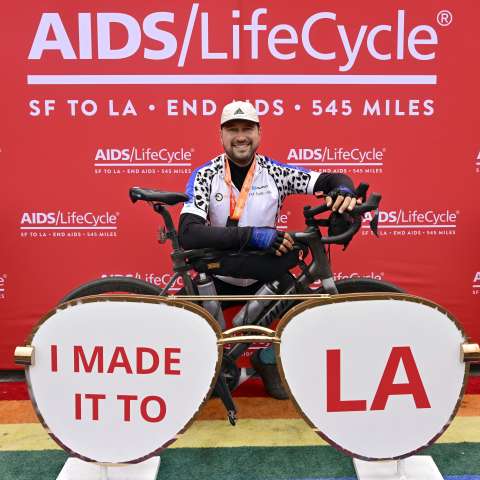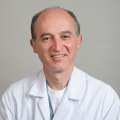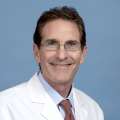For Santa Barbara resident Thomas Johansen, cycling in the 2024 AIDS/LifeCycle Ride from San Francisco to Los Angeles in early June was both a personal milestone and a full-circle moment.
After all, it was on a mountain-bike ride 12 years ago when Johansen first noticed something was amiss with his heart.
Now, after receiving a new heart, Johansen is not just back to biking regularly, but was able to complete the seven-day, 545-mile ride down the California coast, fulfilling a longtime goal and raising funds for AIDS awareness in the process.
Johansen, 55, has long lived a healthy lifestyle, including bicycling and hiking. So he was surprised during that 2012 bike ride through the mountains near his home when he realized he was wheezing – something he’d never experienced before. Not long after, he felt pressure on his chest.
He drove straight to the office of his primary doctor, who promptly ordered a scan that showed that his heart was enlarged. “He said it could just be stress,” Johansen recalled.
But something still didn’t feel right. Johansen insisted on seeing a cardiologist, who confirmed that he had cardiomyopathy – a disease that impairs the heart’s ability to pump blood and, in some cases, can lead to complete heart failure.
Gradual, then sudden, decline
Johansen was put on medication to help control his heart condition and decrease inflammation. But a year later, he was floored by the cardiologist’s suggestion that he consider being added to the waitlist to receive a new heart.
“I’ve always been organic – I never even took painkillers for a headache,” Johansen said. “The idea of being on anti-rejection medications for the rest of my life didn’t seem remotely possible.” (Anti-rejection medications prevent a transplant recipient’s immune system from attacking the new organ.)
Johansen renewed his commitment to healthy living, including trying a vegan diet, even as he sought out additional opinions. During this time, he began seeing , MD, director of the Ahmanson-UCLA Cardiomyopathy Center, who prescribed a new heart medication, along with a diuretic to address the fluid retention Johansen was experiencing because of his heart condition.
In 2016, he was evaluated by the Heart Transplant Selection Committee and added to the waitlist to receive a new heart.
Then, one morning in April of 2017, Johansen woke up and realized he was having a ventricular arrhythmia – an abnormal heartbeat that can lead to a heart attack. At his local hospital, a defibrillator was implanted to monitor his heartbeat and deliver a shock if needed to restore a regular rhythm.
Johansen, a Realtor, continued to work, even though it was a struggle. “I couldn’t even walk from my car to the street corner to put up a sign anymore,” he said. Another Realtor would accompany him when he hosted open houses, given that he could no longer climb the stairs to show prospective clients the upstairs levels of the homes.
By now it was August of 2017. On Sunday, Aug. 20, Johansen hosted an open house. “I wasn’t able to stand up, so I sat in a chair and welcomed people while my colleague showed the house,” he said. Despite how he was feeling, Johansen then went straight to a different client’s house to write up an offer.
He recalled what happened next: “I went straight to bed, even though it was only about 5 o’clock. I was just wiped out – I couldn’t breathe. I called a friend, because I felt like I was going to pass out.”
And then everything went black.
When Johansen woke up, his friend was crying and the paramedics were there as well. He’d had 72 ventricular arrhythmias, he was told, before his heart had stopped and then been shocked back to functioning again by the defibrillator that had been implanted a few months earlier.
“It saved my life and brought me back,” he said.
Johansen was admitted to the local hospital, then transferred to UCLA Health to await a transplant. While there, he focused on keeping his spirits up and continued to work with clients by phone. “My colleagues would help me,” he explained. “Many of my clients didn’t even know I was in the hospital.”
UCLA Health has performed more than 2,700 heart transplants, making it one of the most successful programs in the country.
Learn more about the Heart Transplant Program at UCLA Health
Finally, in November of 2017, he received the welcome news that a new heart had been found.
Johansen’s surgery was performed by , MD, director of the Heart, Lung, and Heart-Lung Transplant Programs at UCLA Health and professor of surgery and medicine at the .
After a three-week stay at the Ronald Reagan UCLA Medical Center to recover, followed by three months in a nearby apartment so he could still be monitored regularly by his providers, Johansen was able to go back home.
A leadership role in heart transplantation
Johansen is now back to enjoying life “in full swing” – a reality that’s common for heart-transplant recipients.
“(Johansen) is a good example of the miracle of organ transplantation,” Dr. Ardehali noted. “When an organ fails and you replace it with a new organ, there are no limits – the sky’s the limit.”
The transplant program at UCLA Health has done more than 2,700 heart transplants since its inception in 1984, Dr. Ardehali said, making it one of the busiest and most experienced heart transplant programs in the world.
“We continue to push the envelope in expanding access to donor hearts and offer this lifesaving option to as many patients as possible,” he said.
This includes being able to offer transplants to older patients, in their mid-70s, who might not be considered candidates elsewhere, he said, as well as having the technology and expertise to place patients on ventricular assist devices while they await transplants.
Giving back and spreading awareness
Since receiving his new heart, Johansen has mentored other patients awaiting heart transplants, either visiting them in person at UCLA Health or talking to them by phone to answer their questions and serve as an inspiration for post-transplant life.
Johansen continues to take a number of medications and is still seen at UCLA Health every three months.
Within this framework though, he’s thriving: last year, he hiked in the Dolomite Alps in Italy, and he’s also hiked to the top of Yosemite Falls and to the bottom of the Grand Canyon. Having successfully completing the AIDS/LifeCycle Ride, his next adventure will be visiting his native Denmark over the summer, where he plans to do more cycling.
“I make sure to prioritize my rest,” Johansen said, “but other than that, I have no limitations.”






